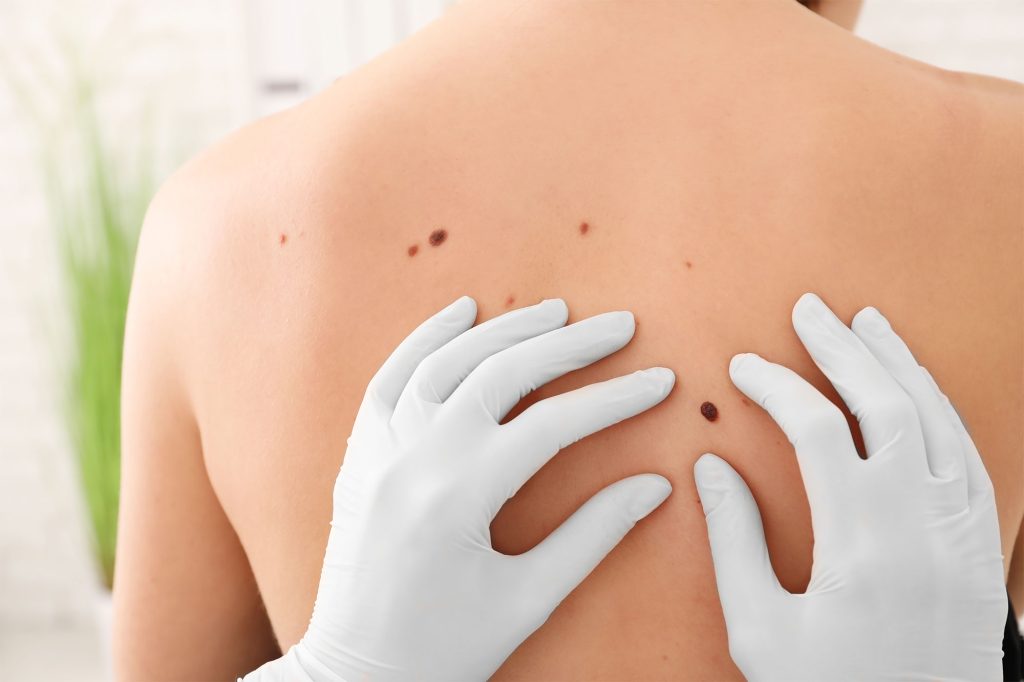West Michigan Plastic Surgery
8175 Creekside Drive, Suite 100
Portage, MI 49024
Phone: (269) 222-1611
Monday–Thursday: 8 a.m.–5 p.m.
Friday: 8 a.m.–4 p.m.
West Michigan Plastic Surgery
3035 Capital Ave SW, Suite 110
Battle Creek, MI 49015
Phone: (269) 222-1611
Tuesday: 8 a.m.–5 p.m.
Friday: 12:30 p.m.–4 p.m.
Skin cancer is the most common type of cancer among men and women in the US. Fortunately, early detection can lead to effective treatment. West Michigan Plastic Surgery offers a variety of skin cancer treatment options.
Dr. Scott Holley uses his skills in reconstructive and cosmetic surgery and surgical finesse, to achieve excellent aesthetic results for patients seeking skin cancer treatment in Kalamazoo, and Grand Rapids.
What Is Skin Cancer Surgery?
Skin cancer surgery refers to the surgical removal of cancerous cells from the skin. Surgery can be done using different techniques, and the choice will depend on the type of cancer, where it is located, and the stage of growth.
Types Of Skin Cancer Surgery
- Mohs Surgery: Skin cancers that have not spread and are caught early are often treated with Mohs surgery. Mohs is a procedure in which thin layers of skin are gradually removed from the site of the skin cancer until the patient is cancer-free. It is a highly effective treatment for basal cell carcinoma and squamous cell carcinoma.
- Simple Excision: A scalpel is used to remove the cancerous growth as well as a small area of surrounding tissue.
- Curettage and Desiccation: A curette (thin, spoon-shaped surgical tool) is used to scrape and remove the lesion. After the lesion is removed the area is treated with an electrode to reduce bleeding and kill the remaining cancer cells.
Other skin cancer treatment options include:
- Cryosurgery – uses liquid nitrogen to freeze and destroy the cancer cells.
- Topical chemotherapy – application of anti-cancer drugs to the skin.
- Radiation Therapy – use of radiation from X-rays.
Candidates For Skin Cancer Surgery
Skin cancer surgery is suitable for people with non-melanoma and melanoma skin cancer. The type of surgery recommended will vary depending on the size, type, and location of the cancerous growth.
How Does It Work?
Skin cancer surgery is most commonly done as an in-office surgical procedure under local anesthesia. However, more extensive excision and reconstruction cases may require treatment at an outpatient surgery center under IV sedation or general anesthesia.
Results
Results of skin cancer treatment are immediate because the cancer cells are completely removed. However, patients must closely follow post-operative instructions regarding wound care, for optimal healing.
Reconstruction surgery is often required after skin cancer surgery to address defects and restore the normal appearance of the skin. Skin flaps heal relatively quickly over several weeks, but skin grafts may take several months to fully mature.
Recovery
After skin cancer surgery, some soreness and swelling around the incision site is normal. Depending on the extent of the operation, wounds can take 1-3 weeks to heal. The incision sites should be kept clean and protected for 48 hours. Most can resume normal activity within a few days to a week.
FAQ’s About Skin Cancer
Who is at risk for skin cancer and why?
Skin cancer can affect anyone, because it is caused by overexposure to ultraviolet radiation from the sun. However, some people are at higher risk of skin cancer because they have fair skin, a family history of skin cancer, or a personal history of sunburns. People that live in a high altitude climate, have numerous skin moles, or spend a lot of time in the sun, have an increased risk of skin cancer.
Does my insurance cover skin cancer surgery by a plastic surgeon?
Yes. Treatment of any abnormal or cancerous skin lesion is a covered insurance benefit no matter what type of Surgeon or Dermatologist performs the removal or reconstruction.
What are the most common types of skin cancer?
The most common types of skin cancer are basal cell carcinoma and squamous cell carcinoma. Malignant melanoma is less common but more serious.
Are there other skin growths I should know about?
Moles and keratoses are other common skin growth. Moles are colored growths on the skin that are usually harmless, but if the size, shape, or color of a mole changes, it could signal melanoma. An actinic keratosis is an area of brown or red scaly skin that can develop into squamous cell carcinoma.
What are the signs of skin cancer?
Basal cell carcinoma often resembles a normal mole and may begin as a shiny bump or nodule that is clear, pink, or red. Squamous cell carcinoma often appears as rough, thick, scaly patches, and can also look like warts.
Melanoma is usually indicated by a change in the size, shape, or color of an existing mole. The ‘ABCD’ rule is a useful tool for identifying a suspicious mole: Asymmetry – one half of the growth does not match the other half, Border is irregular, Color is uneven, Diameter changes, usually gets larger.
Who should I consult for a skin check?
If you think you may be at risk for skin cancer, you can have a skin examination done annually by your family physician. However, if you notice changes in moles or other skin growths, it’s best to consult with a plastic surgeon or dermatologist for a detailed skin check.
How is skin cancer diagnosed?
A skin biopsy is used to diagnose cancer. It is a procedure in which a small sample of skin tissue is removed and tested for skin cancer. This option will be discussed and often recommended at initial consultation if a suspicious lesion is identified.
Which skin cancer treatment is right for me?
During your consultation, Dr. Holley will discuss the skin cancer treatment options available, and recommend the most appropriate procedure for the type of skin cancer you have. It’s important to ask about the pros and cons of each before making your decision. Dr. Holley will also review the possible risks and complications, and address your specific concerns.
How can I prevent a recurrence of skin cancer?
Available data suggest that patients who have been diagnosed with skin cancer have a higher risk of developing the disease again. It’s therefore essential to schedule routine follow-up visits and take preventative measures such as:
- Wearing protective clothing, including a broad-brimmed hat, when going outdoors for extended periods.
- Avoiding prolonged exposure to the sun.
- Using a broad-spectrum sunscreen when going out in the sun.
- Conducting regular self-checks, and consulting a plastic surgeon or dermatologist if you notice a suspicious skin growth.

